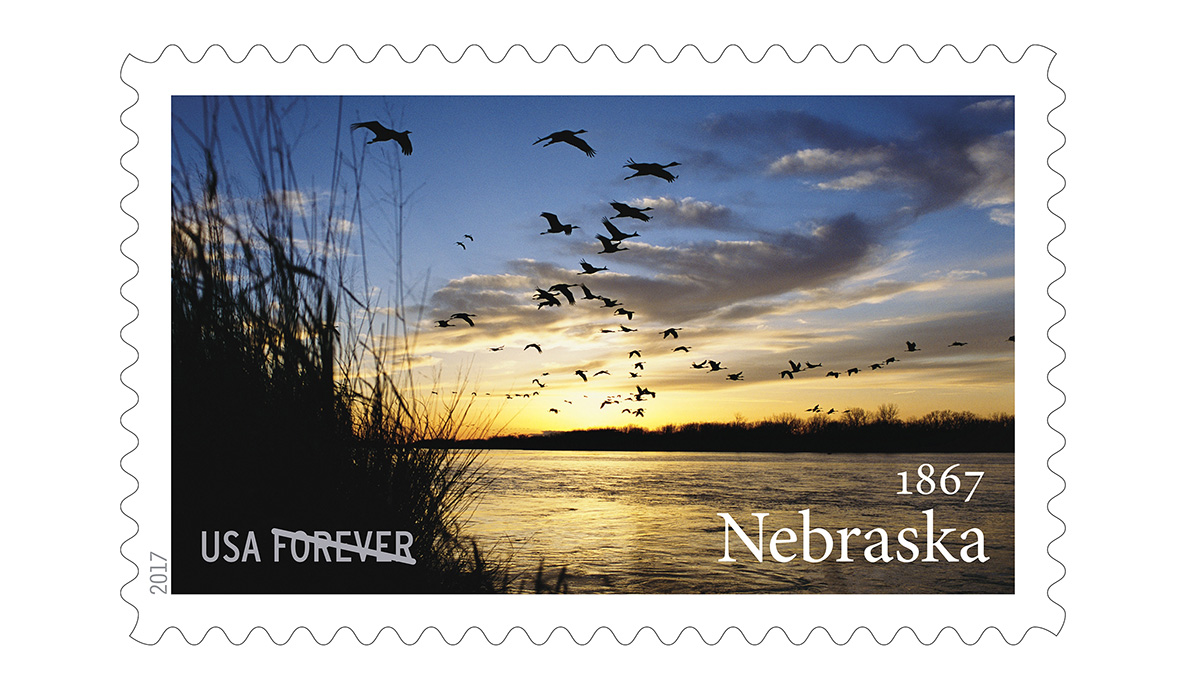Michael Forsberg photo immortalized on U.S. stamp
A Sandhill cranes photograph commemorates Nebraska's statehood sesquicentennial.
2.22.2017
The size of the print is tiny, but its significance looms large.
On March 1, conservation photographer Michael Forsberg has his work immortalized when his image of sandhill cranes over the Platte River is dedicated as a U.S. stamp. The stamp commemorates Nebraska’s 150th year of statehood and represents an important part of the state’s natural heritage.
Having grown up in Nebraska and now based in the state capitol of Lincoln, Forsberg has dedicated much of his 20-year career to photographing wildlife on North America’s Great Plains. Sandhill cranes are a big part of that story. Standing almost four feet tall with a wingspan approaching six feet, sandhills have a migration pattern that spans from northern Alaska to Mexico. Thousands of the birds stop over to rest and feed along the wetlands and prairies between Grand Island and Kearney, Nebraska, roosting on shallow sandbars in the Platte River to avoid predators.
“Each March, the Platte River in south central Nebraska is the stage for one of the greatest wildlife spectacles in North America,” says Forsberg. “Here, millions of migrating birds in the Central Flyway, including a half million cranes, funnel through the Platte River valley for weeks to rest and refuel while on a long migratory journey between southern wintering grounds and northern nesting grounds. It's the largest gathering of cranes anywhere in the world.”
How the photo was made
For this photo, Forsberg wanted to connect the river, prairie, sunset, and cranes. He scouted locations for weeks and then built a one-man blind out of garden fence and hay. He left it in the location for a few more weeks to blend with riverbank scenery and become unnoticeable to the cranes. When the cranes arrived for their stopover, Forsberg entered the blind each afternoon while the birds were away feeding, and he remained until the next morning when they departed again. It took almost a month of this routine for Forsberg to capture this image.
“This photograph shows ancient birds making their migration at sunset across the Platte River,” says Forsberg. “That river is Nebraska’s lifeline and serves as the great artery of the Plains. The image also shows the Plains grass, which is the historical landscape of this area. It’s very important to the ecology of the region, and there would be no economy without this underlying ecology. I really hope this scene will still be here after another 150 years of Nebraska statehood.”
Long odds
The U.S. Postal Service approached Forsberg about using his image, marking the second time he’s had one of his photographs featured on a stamp (the previous was in 2001). Those are some extremely long odds, especially considering that the Postal Service receives about 40,000 image submissions for stamps each year and considers only about 20 to 25 final images. “That’s not the way this job normally works,” says Forsberg. “Normally, you’re out there knocking on doors. So this was a really nice surprise. It’s especially nice because the image represents part of our natural heritage, which I think is really important.”
Jeff Kent is editor-at-large of Professional Photographer.
Tags: wildlife photography


